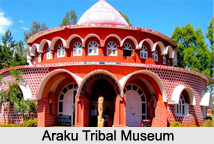 Ganga Golden Jubilee Museum, situated in Bikaner district of Rajasthan, houses some of the most unique and beautiful collections of sculptures, artworks and historical artefacts. It was established in the year 1937, on the golden jubilee celebrations of Maharaja Ganga Singh. It is divided into various sections in which different articles have been placed grouping them according to their historical significance and hierarchy. Run by the Government of Rajasthan, the rare articles of the museum take the visitors in a tour around the bygone eras of the district. The principle sections of the museum comprise Litho-prints of the British interpretation of the war of Independence 1857, Dr. L.P. Tessitori Memorial Section, Miniature Paintings and Folk-Arts, Armoury, Sculpture, Terracotta and Bronzes, History, Local Arts and Crafts and Maharaja Ganga Singh Memorial.
Ganga Golden Jubilee Museum, situated in Bikaner district of Rajasthan, houses some of the most unique and beautiful collections of sculptures, artworks and historical artefacts. It was established in the year 1937, on the golden jubilee celebrations of Maharaja Ganga Singh. It is divided into various sections in which different articles have been placed grouping them according to their historical significance and hierarchy. Run by the Government of Rajasthan, the rare articles of the museum take the visitors in a tour around the bygone eras of the district. The principle sections of the museum comprise Litho-prints of the British interpretation of the war of Independence 1857, Dr. L.P. Tessitori Memorial Section, Miniature Paintings and Folk-Arts, Armoury, Sculpture, Terracotta and Bronzes, History, Local Arts and Crafts and Maharaja Ganga Singh Memorial.
Sculptures of Ganga Golden Jubilee Museum
A rare artefact of Ganga Golden Jubilee Museum include the sculpture of Jain Saraswati belonging to 11th to 12 century having a height of four feet and eight inches and made of a single marble piece. It was discovered from the village Pallu in Ganganagar and is a magnificent testament of medieval Indian sculpture. Another sculpture is of a `Nartaki` belonging to 10th to 11th century. This exquisite one foot high bronze idol was discovered from large sand dune of village Amarsar in Tehsil Sujangarh. Sculptures belonging to Harappan age are also housed in the medium.
Paintings of Ganga Golden Jubilee Museum
The museum displays an amazing collection of Rajasthani miniatures belonging to all the sub-schools of Rajasthan including Jodhpur, Jaipur, Mewar, Bundi and Bikaner.
Terracota Collections of Ganga Golden Jubilee Museum
The museum is a magnificent storehouse of early terracotta art of India. Some of these belong to early Gupta period which were discovered from the ancient Theris of Rang Mahal in 1017 AD. These Theris have been in existence since the time of Indus Valley Civilization.
Lacquer Work of Ganga Golden Jubilee Museum
Lacquer work exhibits of the museums are the manifestation of artistic mastery. Lacquer crafts forms a speciality of Bikaner region which is done on glass, metal, wood, leather, stone or ostrich egg shells and the artisans are known as `Ustaads`.
Wood and Stone Artefacts of Ganga Golden Jubilee Museum
Wood and stone carved articles of Bikaner find a special place in the arena of arts for their mesmerizing beauty. Some of these also form the exhibits of Ganga Golden Jubilee Museum. Some of the prominent articles include a typical Ikka (horse drawn cart), a model of the Gajner Palace of Bikaner, a wooden casket, a teakwood table and a chariot with intricate designs.
The Anup Library of Ganga Golden Jubilee Museum
This library preserves a precious and rare collection of Sanskrit manuscripts brought in 17th century by Raja Anup Singh from the Deccan.
Other Artefacts of Ganga Golden Jubilee Museum
Other famous artefacts of the museum include a silk robe of Prince Salim, also known as Furgal, which belongs to 1596 AD. This Furgal was a gift to Raja Rai Singh of Bikaner by Jahangir (Prince Salim). Raja Rai Singh was one of the closest officials of Jahangir. The museum also houses various `Farmans`, the records of war adventures, having original imperial seals issues by Mughal Emperors including Shah Alam, Aurangzeb, Shah Jahan and Jahangir. Various ancient coins, Rajasthani war weaponry and Litho prints of British Empire have also been preserved here. Old photographs, hunting objects, weapons, trophies, ancient cameras and movie projectors belonging to Maharaja Karni Singh, a great sportsman, also form a major attraction of the museum. There is also a huge collection of black and white photographs of ancient India and life size paintings of various dignitaries.


















